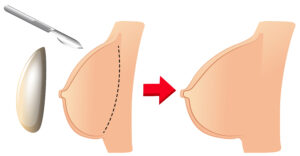Overview:
Breast augmentation is a cosmetic surgical procedure that increases breast size and improves breast shape. It is one of the most popular cosmetic surgeries for women.
The procedure involves inserting silicone or saline implants under the breast tissue or chest muscle. Breast augmentation can be performed for a variety of reasons, including:
- To increase breast size
- To improve breast shape after pregnancy or weight loss
- To create a more balanced appearance
If you are considering breast augmentation, it is important to consult with a board-certified plastic surgeon to discuss your goals and expectations. The surgeon will be able to advise you on the best type of implant for you, as well as the risks and benefits of the procedure.
Why it’s done?
Breast augmentation is done for two main reasons: cosmetic and reconstructive.
-
Cosmetically: It’s the more common reason. Women choose it to increase breast size, improve shape after weight loss or pregnancy, or achieve a more balanced look. It can boost self-confidence and body image.
-
Reconstructively: Breast implants can restore breast volume lost due to mastectomy (breast removal) or injury, or correct congenital breast asymmetry (uneven breasts). This can help women feel whole again after experiencing breast cancer or other issues.
Risks Of Breast Augmentation:
Breast augmentation, like any surgery, carries risks and potential complications. Here’s a breakdown of some of the common ones:
-
Implant complications:
- Rupture or deflation: Saline implants can leak and deflate noticeably, while silicone gel implants may rupture silently.
- Capsular contracture: Scar tissue forms around the implant, causing the breast to feel hard and look wrinkled.
- Changes in nipple or breast sensation: You may experience numbness, tingling, or increased sensitivity in the breasts and nipples.
-
Surgical complications:
- Infection: As with any surgery, there’s a risk of infection at the incision site.
- Bleeding: Though uncommon, bleeding can occur during or after surgery.
- Anesthesia risks: Reactions to anesthesia are possible, though serious ones are rare.
- Poor scarring: Unsightly scars may develop around the incision sites.
-
Other potential issues:
- Breast implant-associated anaplastic large cell lymphoma (BIA-ALCL): This is a rare form of non-Hodgkin’s lymphoma that can develop in the scar tissue around the implant.
- Breast implant illness (BII): Though not a recognized medical condition, some women report flu-like symptoms, fatigue, and joint pain after getting implants. More research is needed to confirm a link.
- Difficulty breastfeeding: Breastfeeding may be difficult or impossible after augmentation, depending on the type of implant and placement.
If you’re considering breast augmentation, it’s vital to discuss these risks thoroughly with your board-certified plastic surgeon. They can explain your individual risk factors and help you decide if the benefits outweigh the potential complications.
Breast implant-associated anaplastic large cell lymphoma:
Breast implant-associated anaplastic large cell lymphoma (BIA-ALCL) is a rare form of cancer that can develop around breast implants, particularly textured surfaces. It’s important to note that BIA-ALCL is not breast cancer, but a cancer of the immune system. While the risk is low, it’s crucial to be aware of symptoms like persistent swelling, lumps, or pain near the implant. If you have textured implants and experience any changes, see your doctor for evaluation.
Breast implant illness:
Breast implant illness (BII) refers to a collection of symptoms some women experience after breast augmentation surgery. It’s not yet a recognized medical diagnosis because the symptoms are varied and non-specific. These can include fatigue, headaches, joint pain, and trouble concentrating. The cause of BII remains under investigation, with theories suggesting a reaction to implant materials or capsule formation. While some women report improvement after implant removal, more research is needed to confirm a clear link between implants and BII.
How you prepare for breast augmentation?
Preparing for breast augmentation involves getting your body and mind ready, as well as some logistical planning. Here’s a rundown:
- Consultations and Clearances: Your surgeon will discuss your goals, expectations, and medical history. They’ll likely recommend pre-operative tests like blood work and mammograms.
- Optimize Your Health: Strive for a healthy weight and maintain a balanced diet. Quit smoking well before surgery, as smoking hinders healing.
- Logistics: Arrange for someone to drive you home after surgery and help you in the initial recovery period. Discuss any medications or supplements you take with your doctor, as some might need adjusting.
- Prepare Your Home: Create a comfortable recovery space with pillows for support and loose clothing for easy wear. Stock up on essentials like pain medication (as prescribed by your doctor) and healthy easy-to-prepare meals.
- Follow Surgeon’s Instructions: These might include stopping certain medications, fasting beforehand, and showering with antibacterial soap.
Remember, this is a general overview. Your surgeon will provide specific instructions tailored to your situation. It’s crucial to follow them carefully for a smooth surgery and recovery.
What you can expect?
Breast augmentation recovery involves a few phases with some potential discomforts but also gradual progress towards your desired results. Here’s a breakdown of what you can expect:
Immediately After Surgery:
- Discomfort and Soreness: You’ll likely feel sore and tender in your chest area, especially when moving your arms. Pain medication will help manage this.
- Swelling and Bruising: Expect swelling and bruising around the breasts and incision sites. This will gradually subside over the next few weeks.
- Limited Activity: Initially, you’ll need to restrict strenuous activity and avoid lifting heavy objects.
The First Few Weeks:
- Gradual Improvement: You should feel progressively better each day with reduced pain and swelling.
- Wearing a Surgical Bra: Your surgeon will likely recommend wearing a special supportive bra for several weeks to help with healing and shaping.
- Follow-up Appointments: You’ll have follow-up appointments with your surgeon to monitor healing and adjust dressings.
Recovery and Beyond:
- Returning to Normal Activities: Most women can resume normal activities within 4-6 weeks, gradually increasing exercise intensity.
- Final Results: It can take several months for final swelling to subside and your breasts to settle into their permanent shape.
- Scars: Incisions will likely leave scars, though they’ll fade over time. Your surgeon will use techniques to minimize their visibility.
Long-Term Considerations:

- Maintaining Your Implants: Schedule regular check-ups with your surgeon to monitor implant integrity.
- Future Procedures: Breast implants are not lifetime devices. You may need additional surgery to replace or adjust them over time.
- Breastfeeding: Breastfeeding may be possible after augmentation, depending on implant placement and technique. Discuss this thoroughly with your surgeon before surgery.
Remember, recovery is an individual process. It’s important to communicate any concerns or discomfort to your doctor and follow their post-operative instructions diligently for optimal healing and results.
Results:
Breast augmentation results can be very satisfying, but it’s important to manage expectations. Initially, you’ll see increased breast volume right after surgery. However, final results take time as swelling subsides and tissues settle. Within a few months, you can expect breasts that look and feel more natural, with the desired size, shape, and improved symmetry. Remember, final results depend on factors like your starting anatomy, implant choice, and surgeon’s skill. Consultation with a board-certified plastic surgeon is key to discuss your goals and achieve the natural-looking enhancement you desire.






